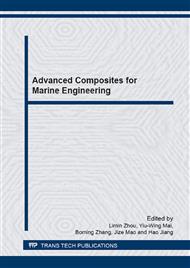p.161
p.169
p.181
p.188
p.194
p.202
p.210
p.220
p.243
Effects of Curing Temperature on Glass Fiber/Urethane Composite’s Mechanical and Thermal Properties
Abstract:
Effects of curing temperature on glass fiber/urethane composite’s mechanical and thermal properties were investigated in this paper. L100 and curing agent C3 were mixed sufficiently with the mass ratio of 100:15 at the temperature of about 50°C, and 3 layers of glass fibers with the size of 10cm×30cm (the thickness of each layer is 0.2mm) were prepared. Then glass fabric/L100 polyurethane composites were fabricated by vacuum-assisted hand lay-up process at the temperature of 150°C, 160°C and 170°C, respectively. As the resin system is used in pultrusion process which demands the resin system can cure adequately within 5min to 15 min. The isothermal differential scanning calorimetry (DSC) method was used to investigate the curing time at the above three temperatures to testify whether the resin system can cure during a short span of time to meet the requirement. The results demonstrate that L100/C3 resin system cures within 8-10min at the temperature of 150°C and 160°C, while under 170°C, the resin system cures fully within 5min,which clearly show that the resin system meet the basic requirement of fast process. In order to better analyze the effect of curing temperature on sample’s mechanical properties, corresponding mechanical tests were conducted. The tension tests demonstrate that the tensile strength and elongation at break reduce with the rise of curing temperature. The interface strength test and field emission scanning electron microscope photography were conducted. The results show that higher curing temperature leads to lower interface strength. The decrease of the interface strength is due to the different reactivity of three reactive groups in L100. With the rising of temperature, reactivity groups tend to react with curing agent C3, but not to combine with coupling in the surface of glass fiber, hence weakens the link between resin and fiber. This assumption can be confirmed by the DSC tests, which show that curing temperatures have little effects on glass transition temperature of the samples. Additionally, the infrared spectra of the composites cured at the above three different temperatures indicate that curing temperatures exert no significant influence on the composition of the composites. Based on the above results, 150°C is chosen to be the optimal curing temperature for the glass fabric/L100 polyurethane composites.
Info:
Periodical:
Pages:
194-201
Citation:
Online since:
March 2015
Authors:
Keywords:
Price:
Сopyright:
© 2015 Trans Tech Publications Ltd. All Rights Reserved
Share:
Citation:


